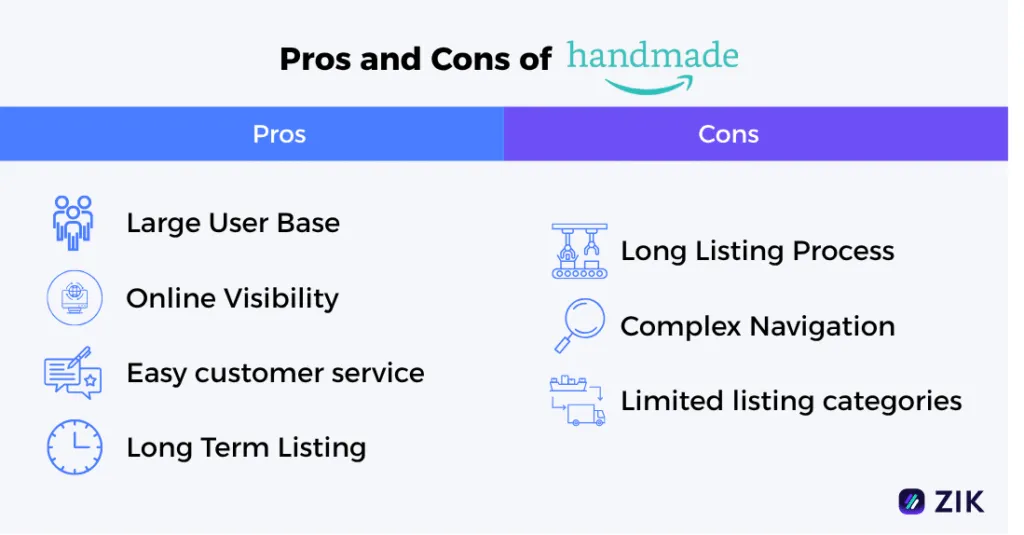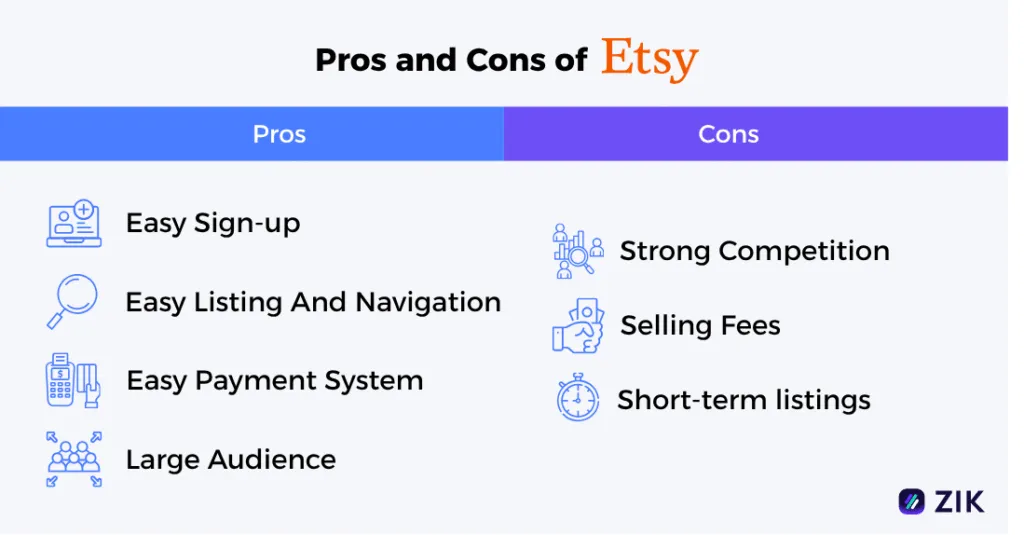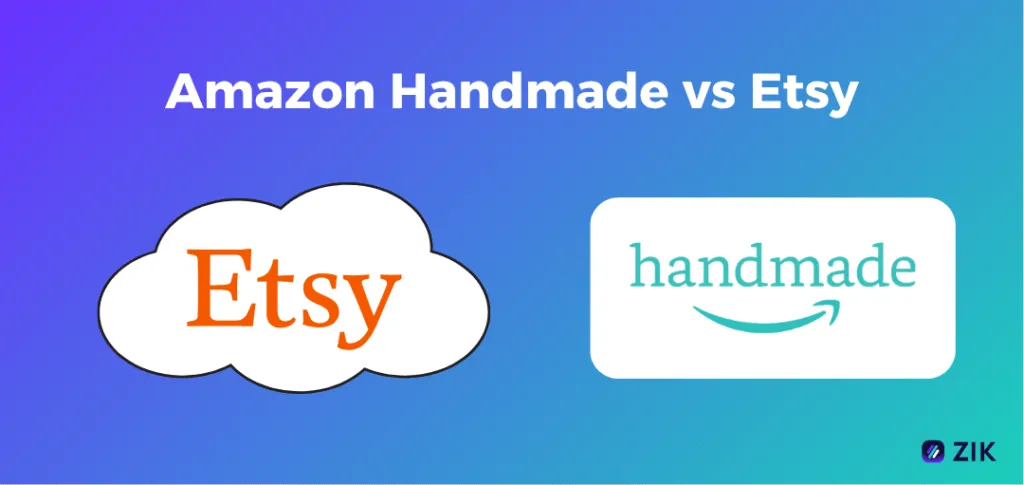There is almost nothing you can’t buy or sell when it comes to doing so online! The days of selling your goods simply at yard sales and in newspapers without having a storefront are long gone. Almost everything, including handmade products, can now be sold from the comfort of your home thanks to the development of technology and e-commerce platforms.
In other words, you can start generating money selling online if you love the arts and can easily handcraft from the comfort of your home. Based on an IMARC report, the global market for handmade crafts reached $718 billion in 2020, proving that making crafts at home can be profitable.
Moreover, the Handmade arts business doesn’t require a huge starting capital; instead, you only need to find the right marketplace to list your items and start selling. In finding the right marketplace, we can consider the two most popular platforms solely built for handmade product sales: Amazon Handmade vs Etsy.
Since the inception of these two marketplaces, they have helped many artisans showcase their creativity to the world. Most sellers, especially new ones, have the question of whether to go for Amazon Handmade vs Etsy.
If you are an Artisan looking for the best platform between these two, this article is definitely for you! We’ll get through all you need to know about Amazon Handmade and Etsy, including the pros and cons, so you can decide on the right platform to start selling. Let’s get right into it!
What is Amazon Handmade?
Amazon, a giant marketplace today, launched a microsite for handmade products in 2015, giving art sellers a chance to gain access to its large audience base of 300 million users and 2 million active sellers.
Hence, Amazon Handmade came into place and aimed to present and connect local and worldwide artisans with their unique and genuinely handcrafted products.
What is Etsy?
Etsy began long before Amazon Handmade in 2005 and specialized in handmade and vintage products, creating opportunities for artisans to list and sell their handmade arts and crafts.
Undoubtedly, Etsy dominates the handmade product market with over 2 million active sellers and 35 million buyers. Amazon’s user base is involved in anything that you can buy or sell online; however, Etsy deals mainly and is the ultimate destination for unique craft products.
You’ll find different craftsmen, artisans, vintage dealers, and small business owners on Etsy with their unique product listings, hence, a perfect place to blend in.
Selling On Amazon Handmade

Pros
Large User Base
Amazon is the largest e-commerce website today, with over 300 million active users. Even though not all Amazon users visit Amazon Handmade, sellers still have access to a higher number of users.
If a buyer searches for a handmade product on Amazon’s main website, they will be redirected to the handmade mini site.
Moreover, people trust and prefer to buy from Amazon, giving handmade product sellers an edge over more potential customers. Based on the 2021 State of the Seller report, 33% of Amazon Handmade sellers saw profit margins of 20% or higher.
Online Visibility
Amazon’s functional search engine system allows buyers to find sellers easily and quickly. Unlike Esty, with high competition, once you optimize your listings, you can show up more quickly in search results.
Easy customer service and delivery
If there is a problem with an order, you may contact the Amazon support team for help through various methods. Moreso, Amazon offers a seamless shipping process, and you may sell to Amazon Prime members using FBA.
Long Term Listing
Once you list your items on Amazon Handmade, it doesn’t expire. So you do not need to renew your listings.
Cons
Long Listing Process
Amazon ensures that the products you are about to list are authentic; hence, the listing takes a long process of a thorough review, sometimes up to two weeks, due to the number of applications for approval.
Navigation
Navigating the Amazon Homemade Seller Dashboard can be challenging if you are just starting in the marketplace, and it will take some time to get familiar with the platform.
Limited listing categories
Only 14 viable categories of items are present on the marketplace, so you may have limited listings if you choose to sell on Amazon Homemade.
Selling On Etsy

Pros
Easy Sign-up
Any Artisan willing to start selling on Etsy can easily create a seller account with a simple process and start selling.
Easy Listing And Navigation
It is easy to list and maintain homemade products you want to sell quickly on Esty. You can upload the product images, add descriptions, and payment details, and you are set to launch your listings.
Moreover, the system is user-friendly, and you can also access the Esty Seller Handbook to navigate the dashboard and other available tools.
Easy Payment System
Using Esty makes it easy for buyers to pay and sellers to process credit card payments with its established payment system.
Large Audience
Esty helps Artisans market their products effectively with over 96 million customers who are specifically looking for handmade products.
Furthermore, you get to relate with a community of sell handmade items Etsy where you can help one another and communicate better.
Cons
Strong Competition
Esty is only known for handmade and vintage items; hence, lots of sellers and opportunities on the marketplace. Based on recent reports, Esty experienced a nearly doubled number of sellers between 2019 and 2020.
The competition makes it hard to build a strong online presence, as customers may be unable to recognize your craft supplies or brand due to many sellers also listing the same products.
Selling Fees
Before selling on an Etsy shop, there are more fees associated with the platform you need to be aware of before listing your items.
Short-term listings
Etsy sellers always have to renew their listings after four months, unlike Amazon, which doesn’t expire.
Selling On Amazon Handmade vs Etsy
Similarities
Custom Handmade product listing
Using any of the online marketplaces, Amazon and Etsy, you can reach a wider audience using numbered lists, descriptions, images, and drop-downs.
Homemade listing
Both platforms only allow homage listing on the platform, which specifically leads a buyer to an ideal market.
Differences
Customer Base
When it comes to the number of users present on both platforms, Amazon has a larger user base; however, Etsy users specifically shop for handmade items.
Registration Process
Etsy marketplace has a simple sign-up process for artists, while Amazon Handmade requires an artisan application that can take weeks or months to get approved.
Product Categories
Compared to Amazon Handmade’s 14 categories, Etsy’s selection of handmade goods is much more extensive, with over 160 different categories to choose from. In other words, Etsy is specifically for selling handmade products.
Production
With Esty, you can have an assistant to help you produce the items, but Amazon Homemade guarantees that your items are produced by you or employees of a business with 20 or fewer employees. Your company may employ fewer than 100 people, then any one of them may produce your goods.
Payment Processing
Esty has quick payments compared to Amazon Homemade. Once a deal has been finalized, the money will be deposited into your bank account. Payment is given 24 days after an item is dispatched through Amazon’s Homemade program.
Amazon Homemade vs Etsy Selling Fees
Listing fees
Users can create permanent, free listings on Amazon, but Etsy costs $0.20 per listing and 5% of each transaction. In addition, the duration for any listing on Etsy is capped at four months before it automatically renews.
Shipping Fees
Standard shipping costs $4.49, and additional shipping expenses are calculated at $0.50 per pound when using Amazon Handmade. All orders on Etsy are subject to a 5% transaction fee and a 5% delivery fee.
How To Start Selling On Amazon Handmade
To start, you’ll need a Seller account on Amazon to join Amazon Homemade. The procedure, while effective, is time-consuming.
To apply, go to the Amazon Homemade minisite and select Apply to sell.
You will require images of your products, production area, and method in JPEG format, along with a summary of about 120 words outlining how you create your items and what materials you use.
Once you’ve completed the application process and submitted your information, Amazon will send you an email including a confirmation number that you can use to view the status of your submission. It is no doubt that Amazon Handmade keeps it exclusive by vetting each listing to guarantee its handmade.
Also, there are 12 different categories you can easily list your items on Amazon Homemade and start selling.
How To Get Started Selling On Etsy
Getting started with selling on Etsy is simple, and anyone can do it. Just choose a location and currency, establish a store name and some products to offer, and arrange your payment and billing methods: the listing fee, transaction fee, and payment processing fee.
It costs $0.20 to list on the Esty marketplace, a 6.5% transaction fee on each final sale price, and a payment processing fee based on fee structures.
Conclusion
There you have it! Choosing between Amazon Homemade and Etsy can be challenging, but you can narrow down your options by learning about their similarities and differences.
Interestingly, numerous internet vendors have succeeded in the Homemade industry, with nearly 25,000 Amazon sellers generating over $1 million in revenue in 2019.
With more shoppers flooding in, you, too, can make a living off of a site like Esty, which has a big and dedicated following of shoppers for handcrafted goods.
Explore New Opportunities with ZIK
If you’re inspired by what artisans are achieving on Amazon Handmade and Etsy, consider expanding your reach to eBay’s thriving handmade and craft categories. The ZIK eBay Competitor Research Tool helps you analyse real sales data, track top-performing handmade listings, and uncover untapped niches before you list. Discover what buyers are actively searching for and craft products that sell successfully on eBay.
Frequently Asked Questions on Amazon Handmade vs Etsy
Here are some frequently asked questions on Amazon Handmade vs Etsy:
Is it better to sell on Amazon or Etsy?
It depends on what you sell. Amazon suits mass-market, scalable products and offers fulfillment through FBA, while Etsy is better for handmade, vintage, or custom items. Amazon provides reach and infrastructure; Etsy offers creativity, lower entry costs, and stronger brand storytelling.
Who is Etsy’s biggest competitor?
Etsy’s biggest competitor is Amazon Handmade, which targets the same market of artisans and small business owners selling handcrafted goods. Other strong competitors include eBay, Shopify, and Walmart Marketplace, all offering sellers alternative platforms to reach niche or mainstream audiences.
How much does Amazon Handmade take?
Amazon Handmade charges a 15% referral fee on each sale, based on the total price including shipping. There are no listing fees or monthly subscription costs for approved sellers. However, if you use Fulfillment by Amazon (FBA), standard storage and shipping fees apply.
What is the best place to sell handmade items online?
The best place to sell handmade items online is Etsy, known for its large community of craft buyers and creative sellers. Other great options include Amazon Handmade, Shopify, and eBay, depending on whether you prioritise reach, branding control, or fulfilment support.
Is Amazon Handmade worth it?
Yes, Amazon Handmade can be worth it if you want access to Amazon’s massive customer base and don’t mind the 15% referral fee. It’s ideal for artisans who can scale production and meet delivery expectations, though Etsy offers more creative control and community support.
What is the downside of Etsy?
The main downsides of Etsy are its high competition, increasing fees, and limited branding control. Sellers also face copycats and pricing pressure, as similar handmade items are often undercut. Additionally, Etsy’s strict policies and sudden account suspensions can be challenging for small creators.













